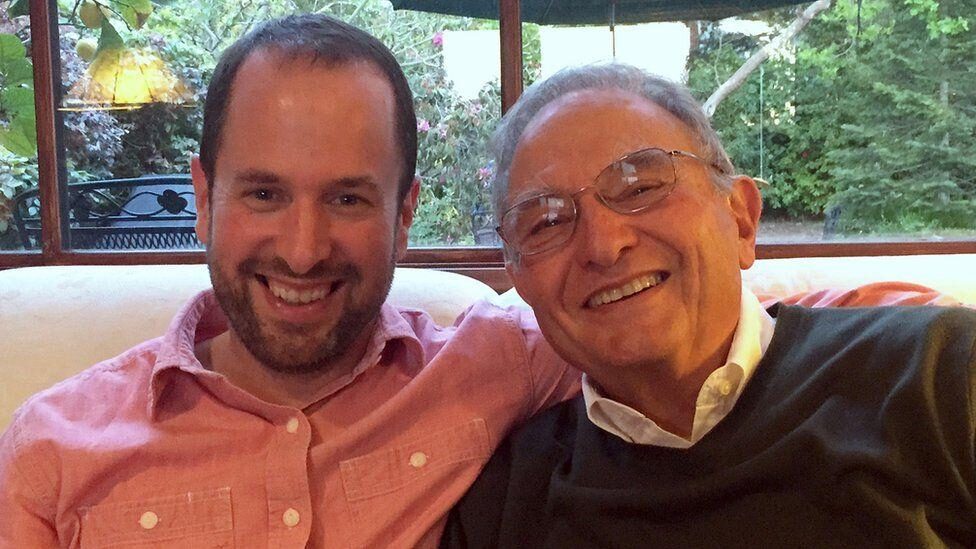BTN News: In 2016, James Vlahos received devastating news: his father was diagnosed with terminal cancer. As the reality of losing his father set in, James, who resides in Oakland, California, decided to make the most of their remaining time together. He embarked on a personal project, conducting an oral history with his father, recording hours upon hours of his life story. “I loved my father, and I was losing him,” James recalls, reflecting on his drive to preserve every detail. As an artificial intelligence enthusiast, James soon found himself wondering, “What if I could make this interactive?”
James’s unique project evolved rapidly. Before his father, John, passed away in 2017, James transformed the recorded stories into an AI-powered chatbot. This creation, designed to answer questions about John’s life in his own voice, marked a step into a world where technology meets emotion—a way to hold on to a loved one’s essence beyond their death.
The Digital Resurrection: From Fiction to Reality
For decades, science fiction has explored using artificial intelligence to revive memories and personalities of the deceased. Today, technology has advanced enough to make these ideas a reality. In 2019, James took his creation a step further, launching Hereafter AI, an application allowing users to create similar interactive memories of their loved ones. “It doesn’t take away the pain,” James admits, “but it gives you more than you otherwise would have had.”
Unlike traditional memorials, Hereafter AI allows users to upload photos and recordings of their loved ones, transforming them into interactive experiences. But James’s venture is not the only one pushing the boundaries of grief technology. In South Korea, DeepBrain AI has developed a sophisticated system to create digital avatars of deceased people, capturing their likeness, voice, and gestures. “We’re cloning the likeness of the person to about 96.5% similarity,” says Michael Jung, the company’s Chief Financial Officer. This high level of replication aims to make interactions feel as real as possible, easing the discomfort of speaking to a digital replica of a lost loved one.
A New Legacy: Building a Culture of “Dying Well”
DeepBrain AI’s goal is more profound than just offering a virtual presence. The company envisions a future where this technology contributes to a culture of “dying well.” It is a movement toward preparing for death in a way that leaves behind a “living legacy”—a rich collection of stories, accounts, and family memories. However, the process of creating these avatars is not cheap; families may pay up to $50,000 for the filming and development of a virtual clone.
Despite the high cost, investors see potential in this emerging market. DeepBrain AI recently raised $44 million in its latest funding round, signaling growing confidence in the popularity and demand for such technology.
The Caution of Using AI in Grief: Expert Warnings
Not everyone is convinced of the benefits of these grief technologies. Laverne Antrobus, a psychologist, warns that people should approach this “technology of mourning” carefully, especially during intense emotional periods. “Loss catches us off guard,” Antrobus explains. “You might feel close to being okay, and then something sets you back.” She advises that people should not rush to use a chatbot or avatar of a deceased loved one. “You need to feel quite stable before engaging with something like this. Take things very slowly.”
A Rising Industry: The Technology of Death
Grief is a deeply personal process, unique to each individual. Yet, there are commonalities, like the administrative burdens that often follow a loved one’s death. From closing bank accounts to managing social media profiles, the bureaucratic tasks can be overwhelming.
To help alleviate these stresses, Settld, a UK-based online platform, assists grieving families by handling communication with various organizations. Founded in 2020 by Vicky Wilson after her grandmother’s death, Settld offers a way to automate much of the administrative workload. “When someone dies, managing the average estate involves around 300 hours of work across 146 tasks,” says Wilson. “We estimate that about 70% of that work can and should be automated.”
The platform, which collaborates with over 950 entities, including banks and utility companies, allows users to upload necessary documentation and track responses, providing a streamlined approach to an often-chaotic process.
A Billion-Dollar Industry Fueled by a Pandemic
The global market for grief technology, also known as “death tech,” is currently valued at over $123 billion. This sector has experienced rapid growth, accelerated by the coronavirus pandemic. “COVID-19 highlighted the importance of life,” says David Soffer, editor-in-chief of TechRound. “It helped break down some of the taboos surrounding death and made people more open to discussing it, leading to greater acceptance of technology as part of the mourning process.”
According to Soffer, the real power of grief technology lies not just in its ability to notify multiple parties or create digital mementos but in its potential to address the non-technological aspects of grief. “When technology evolves to solve non-technical problems, like the mourning process, that’s the real purpose of technology,” he says.
The Limits of Technology: The Need for Human Connection
While technology offers new ways to preserve memories and manage grief, experts caution against relying solely on digital solutions. “There’s no substitute for human support when overcoming grief,” says Antrobus. “I can’t imagine a scenario where technology takes over the most traditional aspects of mourning—those that involve feeling close to others, feeling cared for, and appreciated.”
As we navigate this new frontier, it becomes clear that while AI can offer innovative ways to remember and honor the dead, it must coexist with the age-old, deeply human need for connection and empathy.
By integrating AI tools into the grieving process, the intersection of technology and mourning is just beginning to unfold. While companies like Hereafter AI and DeepBrain AI continue to innovate, they must balance the profound emotional needs of those who mourn with the capabilities of artificial intelligence, ensuring that technology complements rather than replaces the timeless aspects of human connection.


